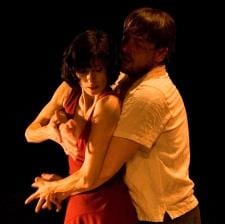Two penetrating, unsentimental depictions of relationships debuted Nov 26 in the Moonhorse Dance Theatre program Dances in a Small Room. Artistic director Claudia Moore commissioned two modern dances, Lone Some by Tedd Robinson and Half an Hour of Our Time by James Kudelka, which she performs with Dan Wild.
In Robinson’s piece, Moore is constantly making busy — a wiggling stutter step standing in place, her arms a constant swirl — perhaps with daily chores or washing herself, there might even be a child. She’s preoccupied and self-regarding. Wild sits and watches her, rushing up behind, at first with love and lust, to hold her. But she’s busy and spins away. Eventually he stops wanting to hold her and leaves. With staccato breaths, Moore works more frantically. She feels her man’s absence more than his presence.
The soundtrack is two songs: Cyndi Lauper singing Smokey Robinson’s “You Really Got a Hold On Me” and Rickie Lee Jones singing Paul McCartney’s “For No One.”
The spare, short work is deceptively simple; Moore’s commitment makes it very moving.
The Kudelka piece starts off slow, beginning with a series of static tableaux. The lights come up on Moore sitting alone on a settee, upright, looking off. Black out. The lights come up on Moore, in a more relaxed posture, still deep in thought. Lights up on Moore joined by Wild, both looking off. And so on. They start to move in a stately paced series of interlocking hugs, sexual clutches and slow dances, arms corkscrewing around each other’s arms. But the moves build in passion and complexity, the repertoire of feints and countermoves grows — as in all relationships over time. A terrible momentum is building.
There’s an endless push and pull between the two — literally. One recurring segment has the slight and wiry Moore facing Wild, pushing strongly against his hips with her hands; Wild, who has heft, moves a bit but grabs one of her hands as she stretches away from him, caught in an aching arabesque, never able to escape. You can really feel the weight difference between the two; it’s exhausting watching Moore repeat the move.
The piece — whether it represents a real couple or whether it’s a memory is unclear — is done in silence. Each dancer is presented as a roiling cauldron of need. The two swirl around each other, to and fro, as if neither can ever find what they need in the other. Their faces show the weather of time.
And yet they keep coming together in hope. There is tenderness. These aren’t just two people alone; there is connection, especially when they waltz slowly together.
But the distances, the self-involvement, are great. Again, Moore seems the more preoccupied, rarely returning her partner’s gaze. The push/pull becomes increasingly desperate, the frustration and disappointment more palpable.
And still they reach out.
It’s a powerful, poignant piece danced with bravery.
A lot of emotion was packed into the small Tank House Theatre at the Young Centre opening night.


 Why you can trust Xtra
Why you can trust Xtra


